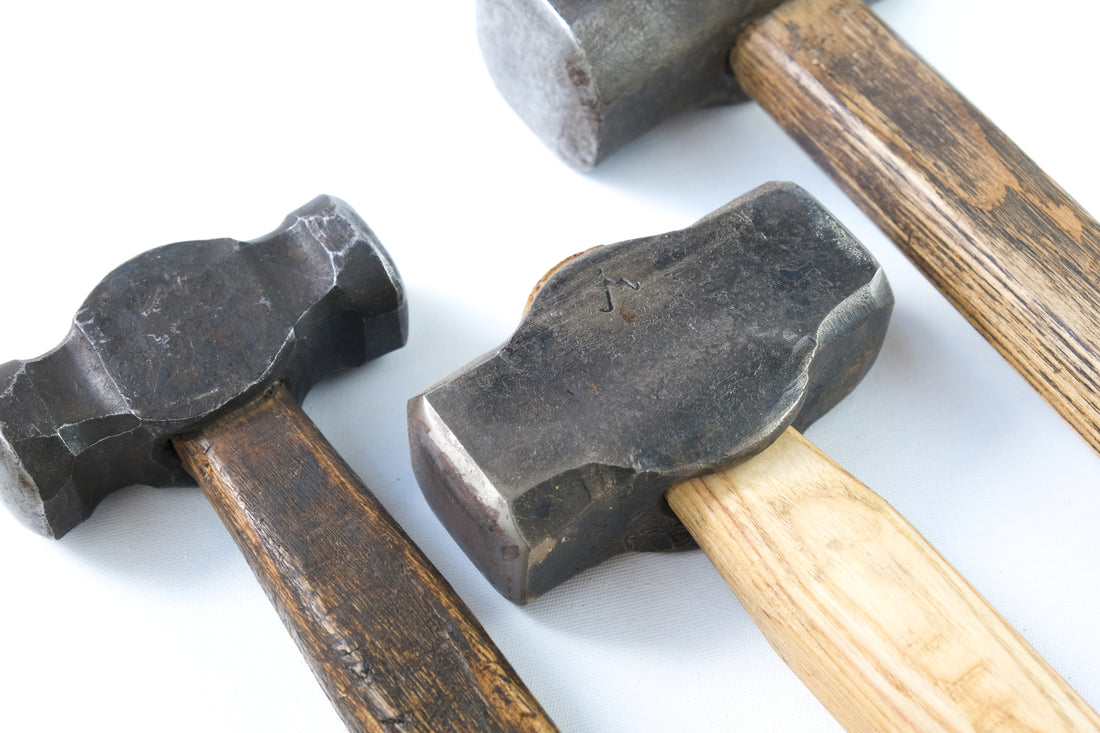Hammer size and design.
During a recent custom hammer order I had some long discussions with the customer about the considerations for what makes a good blacksmith hammer. The learnings might be valuable to other newcomers to the trade - to make the most of the hammers you already have in your shop, or what to look for when buying new. Whether you're jazzing up your toolkit or on the hunt for the next trusty sidekick, this might be for you.
The considerations I will discuss in this blog post are hammer weight, face profile, hardness and handle shape. Keep reading. You might be surprised to read that I don’t think hard and heavy is good for every application.

Hammer hardness
When hard meets soft, soft moves. The harder the hammer and anvil faces the more energy moves into the workpiece. This is great when you are trying to move metal. Squish the hot stuff between a hammer and a hard face. However, while using hardened tool steel is usually advisable to increase the longevity of the hammer, there are a couple times a slightly soft hammer face can be beneficial.
Firstly, while learning. Miss hits will happen and when smashing a hammer straight into the anvil there is a risk something will give. If you have just gone out and dropped a couple hundred on a nice London pattern anvil, you want to protect that. It's easier and cheaper to dress a hammer face than an anvil. However, if the hammer is getting marked working on hot steel it isn't hard enough.
Secondly, having a dedicated soft face hammer to use on struck tools. In this instance, you want to protect the longevity of your special tools (punches, chisels, drifts etc). Having the hammer softer prevents damage. Ultimately you’ll have to replace just one hammer rather than ruining all your tooling. Hammer hardness is a delicate balance between maximizing energy transfer and preserving the longevity of your tools and equipment. The interplay between hard and soft faces can safeguard both your anvil and your valuable struck tools.
Hammer weight
Yes, the heavier the hammer the more power and therefore faster you’ll move metal. Kind of. Throwback to some physics classes and you’ll remember acceleration has a part to play in this too. You are also not a machine, you’ll have to be holding that hammer and swinging it accurately. All this to say, it’s a balancing act between the hammer weight and your strength and endurance. I don't doubt a heavy hammer and the fatigue that comes with it contributes to miss hits, you may find you have better control of a smaller hammer or a comfortable weight for you. This may change over time as you get stronger and more accurate, or change depending on the task. Smaller for more detailed and accurate work or heavy for, well, heavy work. The principle of hammer weight reveals that power isn't solely determined by heft; the harmony between hammer weight and your own strength and precision dictates the effectiveness of your strikes.
Handle shape
I keep my handles consistent thickness over length so it can be gripped anywhere. Being able to choke up on a handle is useful for maintaining accuracy. The thickness of the handle however is preference as much as hammer weight. You know what they say about big hands - thick handles. I also tend to use an octagonal shape on my handles. Two reasons - the angles give slightly better grip than a smooth rounded surface. Secondly, the angles give a sense of orientation - similar to a tennis racket handle. Handle shape is a vital ergonomic consideration, with its thickness and design influencing your grip and control. The choice between different handle shapes, such as the octagonal design, can greatly impact your ability to accurately direct your strikes.
Hammer face
Hammer faces are not perfectly flat. They are crowned. It's not possible to deliver every strike perfectly flat so faces are highest in the centre and gently fade to the edges to accommodate this human error. If you are buying a small drilling, club or sledge hammer online that is not manufactured solely for blacksmithing, you will need to knock off the hard factory edges before you start to use it. Any corner, pattern or imperfection on the hammer face is going to permanently imprinted on your work.
The art of selecting the right hammer size and design for blacksmithing involves a careful consideration of various factors that contribute to both the efficiency and quality of your work. As discussed hammer weight, face profile, hardness, and handle shape are pivotal elements that can significantly impact your forging process. While the common notion might be that heavier and harder is always better, a nuanced approach proves essential. This underscores the importance of adapting your hammer selection to the nature of the task at hand, whether intricate detailing or heavy-duty work.
By delving into these considerations, blacksmiths, both new and experienced, can refine their approach to hammer selection and utilise their tools more effectively. The journey toward becoming a skilled blacksmith involves not just mastering techniques at the anvil, but also cultivating an understanding of the tools that facilitate your craft. It's an art, and your hammer's the brush. So, whether you're customising your hammers or searching for new additions, let these insights guide you toward (buying one of mine) making informed choices that elevate the artistry and efficiency of your blacksmithing. Keep swingin' and forging ahead! 🛠️🔥

8 comments
The cross peen hammer is a must-have tool for metalworkers and blacksmiths. Its unique design allows for precise shaping and spreading of metal. I recently used a cross peen hammer for a small forging project, and the control it offered was impressive. It’s truly a versatile tool that belongs in every serious DIY toolkit.
“Great insights! The cross peen hammer is indeed a versatile tool, especially for metalworking and shaping. Its unique peen end allows for precise control, making it a favorite among blacksmiths. Have you tried using the Maximus 350? I’ve heard it offers excellent balance and durability!”
Great post! I recently worked on a project where I used a cross peen hammer to shape metal more precisely. It’s such a versatile tool, especially for getting detailed work done without damaging the surface. Definitely a must-have in any toolbox!
Great insights on Hammer Wisdom! The versatility of a cross peen hammer really stands out. It’s perfect for metalwork, shaping, and even woodworking. Truly an essential tool in any craftsman’s arsenal.
Great insights on Hammer Wisdom! The versatility of a cross peen hammer really stands out. It’s perfect for metalwork, shaping, and even woodworking. Truly an essential tool in any craftsman’s arsenal.